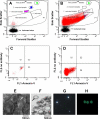Characterization of blood borne microparticles as markers of premature coronary calcification in newly menopausal women
- PMID: 18621859
- PMCID: PMC2544500
- DOI: 10.1152/ajpheart.00193.2008
Characterization of blood borne microparticles as markers of premature coronary calcification in newly menopausal women
Abstract
While the risk for symptomatic atherosclerotic disease increases after menopause, currently recognized risk factors do not identify ongoing disease processes in low-risk women. This study tested the hypothesis that circulating cell-derived microparticles may reflect disease processes in women defined as low risk by the Framingham risk score. The concentration and phenotype of circulating microparticles were evaluated in a cross-sectional study of apparently healthy menopausal women, screened for enrollment into the Kronos Early Estrogen Prevention Study. Microparticles were evaluated by flow cytometry, and coronary artery calcification (CAC) was scored using 64-slice computed tomography scanners. The procoagulant activity of isolated microparticles was determined with a sensitive fluorescent thrombin generation assay. Chronological age, body mass index, serum lipids, systolic blood pressure (Framingham risk score < 10%, range 1-3%), and high-sensitivity C-reactive protein did not differ significantly among women with low (0 < 35; range, 0.3-32 Agatston units) or high (>50; range, 93-315 Agatston units) CAC compared with women without calcification. The total concentration and percentage of microparticles derived from platelets and endothelial cells were greatest in women with high CAC scores. The thrombin-generating capacity of the isolated microparticles correlated with phosphatidylserine expression, which also was greatest in women with high CAC scores. The percentages of microparticles expressing granulocyte and monocyte markers were not significantly different among groups. Therefore, the characterization of platelet and endothelial microparticles may identify early menopausal women with premature CAC who would not otherwise be identified by the usual risk factor analysis.
Figures






Similar articles
-
Microparticle-Induced Coagulation Relates to Coronary Artery Atherosclerosis in Severe Aortic Valve Stenosis.PLoS One. 2016 Mar 24;11(3):e0151499. doi: 10.1371/journal.pone.0151499. eCollection 2016. PLoS One. 2016. PMID: 27010400 Free PMC article.
-
Alterations in platelet function and cell-derived microvesicles in recently menopausal women: relationship to metabolic syndrome and atherogenic risk.J Cardiovasc Transl Res. 2011 Dec;4(6):811-22. doi: 10.1007/s12265-011-9296-9. Epub 2011 Jul 24. J Cardiovasc Transl Res. 2011. PMID: 21786187 Free PMC article. Clinical Trial.
-
Pregnancy history and blood-borne microvesicles in middle aged women with and without coronary artery calcification.Atherosclerosis. 2016 Oct;253:150-155. doi: 10.1016/j.atherosclerosis.2016.09.006. Epub 2016 Sep 9. Atherosclerosis. 2016. PMID: 27639028 Free PMC article.
-
Comprehensive coronary risk determination in primary prevention: an imaging and clinical based definition combining computed tomographic coronary artery calcium score and national cholesterol education program risk score.Int J Cardiol. 2006 Jun 16;110(2):129-36. doi: 10.1016/j.ijcard.2005.09.009. Epub 2005 Nov 21. Int J Cardiol. 2006. PMID: 16303191 Review.
-
Expert review on coronary calcium.Vasc Health Risk Manag. 2008;4(2):315-24. doi: 10.2147/vhrm.s1160. Vasc Health Risk Manag. 2008. PMID: 18561507 Free PMC article. Review.
Cited by
-
The Kronos Early Estrogen Prevention Study (KEEPS): what have we learned?Menopause. 2019 Sep;26(9):1071-1084. doi: 10.1097/GME.0000000000001326. Menopause. 2019. PMID: 31453973 Free PMC article. Review.
-
Moderate-intensity exercise reduces activated and apoptotic endothelial microparticles in healthy midlife women.J Appl Physiol (1985). 2019 Jan 1;126(1):102-110. doi: 10.1152/japplphysiol.00420.2018. Epub 2018 Sep 20. J Appl Physiol (1985). 2019. PMID: 30236051 Free PMC article.
-
Aggregation and microparticle production through toll-like receptor 4 activation in platelets from recently menopausal women.J Cardiovasc Pharmacol. 2009 Jul;54(1):57-62. doi: 10.1097/FJC.0b013e3181ab373d. J Cardiovasc Pharmacol. 2009. PMID: 19528814 Free PMC article.
-
Biologic nanoparticles and platelet reactivity.Nanomedicine (Lond). 2009 Oct;4(7):725-33. doi: 10.2217/nnm.09.61. Nanomedicine (Lond). 2009. PMID: 19839809 Free PMC article.
-
Procoagulant activity, but not number, of microparticles increases with age and in individuals after a single venous thromboembolism.Thromb Res. 2011 Jan;127(1):39-46. doi: 10.1016/j.thromres.2010.10.018. Epub 2010 Nov 23. Thromb Res. 2011. PMID: 21106230 Free PMC article.
References
-
- Agatston AS, Janowitz WR, Hildner FJ, Zusmer NR, Viamonte M Jr, Detrano R. Quantification of coronary artery calcium using ultrafast computed tomography. J Am Coll Cardiol 15: 827–832, 1990. - PubMed
-
- Amabile N, Guerin AP, Leroyer A, Mallat Z, Nguyen C, Boddaert J, London GM, Tedgui A, Boulanger CM. Circulating endothelial microparticles are associated with vascular dysfunction in patients with end-stage renal failure. J Am Soc Nephrol 16: 3381–3388, 2005. - PubMed
-
- Amabile N, Heiss C, Real WM, Minasi P, McGlothlin D, Rame EJ, Grossman W, De Marco T, Yeghiazarians Y. Circulating endothelial microparticle levels predict hemodynamic severity of pulmonary hypertension. Am J Respir Crit Care Med 177: 1268–1275, 2008. - PubMed
-
- Andersson T, Flockhart DA, Goldstein DB, Huang SM, Kroetz DL, Milos PM, Ratain MJ, Thummel K. Drug-metabolizing enzymes: evidence for clinical utility of pharmacogenomic tests. Clin Pharmacol Ther 78: 559–581, 2005. - PubMed
-
- Bairey Merz CN, Shaw LJ, Reis SE, Bittner V, Kelsey SF, Olson M, Johnson BD, Pepine CJ, Mankad S, Sharaf BL, Rogers WJ, Pohost GM, Lerman A, Quyyumi AA, Sopko G. Insights from the NHLBI-Sponsored Women's Ischemia Syndrome Evaluation (WISE) Study: Part II: gender differences in presentation, diagnosis, and outcome with regard to gender-based pathophysiology of atherosclerosis and macrovascular and microvascular coronary disease. J Am Coll Cardiol 47: S21–S29, 2006. - PubMed
Publication types
MeSH terms
Substances
Grants and funding
LinkOut - more resources
Full Text Sources
Medical
Research Materials

